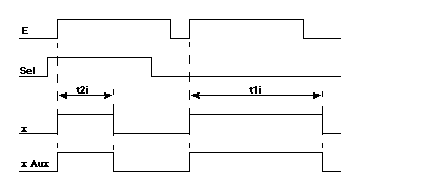|
Reflex function block: 2 value monostable
|
|
|
(Original Document)
|
|
Name
|
Meaning
|
|---|---|
|
E
|
Monostable input.
|
|
Sel
|
Selection of time-out t1i or t2i.
|
|
Direct
|
Selection of block (for string operation).
|
|
x
|
Monostable's physical output.
|
|
x Aux
|
Block's internal auxiliary output.
|
|
Illustration
 |
|
|
Phase
|
Description
|
|---|---|
|
1
|
On the rising edge of input E :
|
|
2
|
When the time-out is over, the x and x Aux outputs change to 0.
|

|
Phase
|
Description
|
|---|---|
|
1
|
On the rising edge of input E of the first block:
Note: Two blocks must not simultaneously have their Direct inputs set to 0.
|
|
2
|
When the time-out is over, the x and x Aux outputs change to 0.
|
|
Note: When stringing together several blocks it is essential to change the statuses of the Sel and Direct inputs only when the status of input E is set to 0.
|
|
